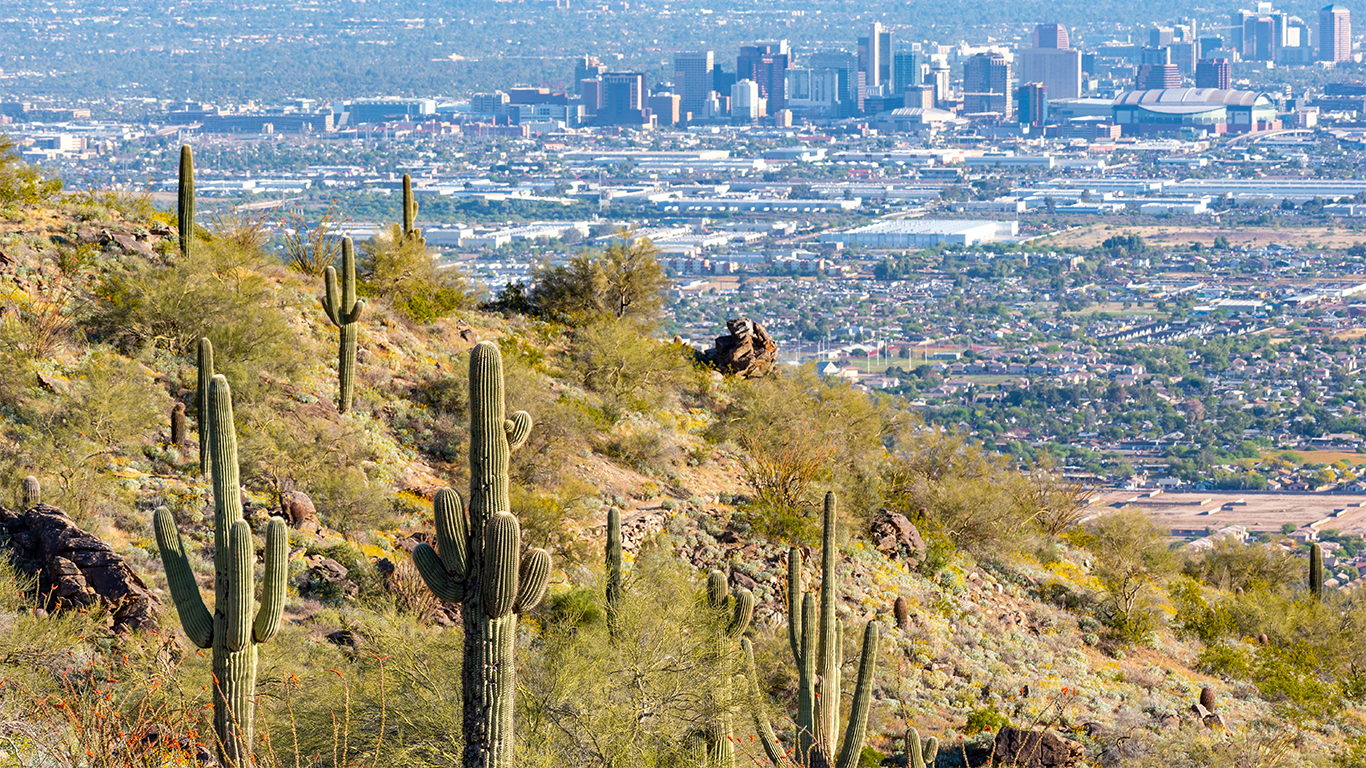Industry-leading companies continue to choose Arizona as a worthwhile place to operate, creating new jobs and diversifying the state’s economy. These substantial investments act as a vote of confidence, making the market more tempting for other businesses. Arizona can capitalize on this surging interest thanks to having an abundance of the one resource nobody can make more of — land. Even with this natural bounty, where and how land is being developed is changing across the state.
Greater Phoenix has long been an attractive place for newcomers, but the trend of where exactly they’re moving to is evolving. According to Greg Vogel, founder and chairman of Land Advisors Organization (LAO), more than half of the population growth will occur in the West Valley.
This subregion is not only less built out than the East Valley, but it has recently added a slew of top-tier employers. According to LAO, TSMC, Microsoft, Amkor Technology, Amazon and Apple constitute around $175 billion in investment and will create more than 17,000 jobs by 2028.
“What we’ve created here has been coined the Silicon Desert, and we expect more investment to occur,” Vogel says. “It has become global news.”
These employees will need places to live, and homebuilders are trying to get out ahead of the demand. Vogel notes that within the last 12 months, 53% of all single-family permits in Greater Phoenix have been issued in the West Valley, up from 38% in 2010.
“We could end up hitting boundaries like the Gila River Indian Community, large regional parks and state land that will guide the future of development,” Vogel says.
Another bellwether for growth patterns is the number of finished lots on the market. Data from LAO shows that the Northwest Valley currently has 8,896 vacant lots available and the Southwest Valley has 8,761. Dividing the number of lots by the quantity of permits pulled in the last year shows how many months it will take to utilize that available land.
Using this equation shows that the Northwest Valley has 22.8 months of supply, and the Southwest Valley has 17.8, with anything between 18 and 22 months constituting a balanced market, Vogel explains.
“We’re at balance, but that’s with fewer permits being pulled in this recent slowdown, so the denominator effect is expanding what was a supply in the lower teens,” he continues. “We expect supply to contract again.”
When looking at the sum of all land transactions in Greater Phoenix and Pinal County over the last year, the West Valley captured 53% of all sales. Within that market share, Vogel notes that 43% of dollars spent was for industrial and data center projects, “which we’ve never seen the likes of before.”
LEARN MORE: 10 major Arizona real estate developments shaping state’s future
Desert dwellers
With the influx of new employers into Arizona, demand for housing has outpaced supply, prompting the state’s lawmakers to address the issue on multiple fronts.
“The Axon legislation, for example, allows for residential as a matter of right in certain circumstances when you have an international headquarters employing more than 1,000 people,” explains Larry Lazarus, president of Lazarus & Silvyn.
Other bills have been adopted to create more housing, such as allowing for the construction of accessory dwelling units at single-family residences without approvals and missing middle legislation requiring cities of 75,000 population or more to allow for duplexes, triplexes, fourplexes and townhomes within one mile of the central business district without having to go through the entitlement process.
That said, Lazarus notes that there has been significant pushback to these measures both from residents and vested interest groups, such as the outcry from historic neighborhoods regarding the potential of multifamily projects being built nearby.
“The City of Scottsdale had a referendum following the Axon project’s approval, after which the legislation was passed to allow this to occur because it’s a major employment opportunity,” Lazarus says. “Now, there’s a potential lawsuit against that legislation from interest groups and neighborhoods that don’t want apartments near them.”
The goals of protecting existing neighborhoods and growing the community are often similar, Lazarus adds, even if they see the issue through different lenses. The vibrant, growing areas of the state needs housing — of all kinds — the most.
“Without it, you start to have a homelessness problem, which affects not only the neighbors but the likelihood of a business coming to the community,” he continues.
Water worries
Arizona has ample land to support continued expansion, but that is not the only natural resource needed. The availability of water is a perennial issue in the desert, which is why state law mandates that home developers in the Valley must prove there is enough water to sustain a project for 100 years.
Tom Buschatzke, director of the Arizona Department of Water Resources (ADWR), explains that the groundwater model used by the agency shows that all supplies have been designated for the next 100 years.
To help growth continue, ADWR established the Alternative Path to Designation of Assured Water Supply (ADAWS) regulation, which allows developers to secure an allotment of groundwater with the stipulation of requiring them to acquire an additional 25% of renewable non-groundwater supplies as an offset.
“If we were to allocate new water, it would suck water away from people who already have it,” Buschatzke continues. “[ADAWS] is much sounder water policy, allowing for more sustainable growth and is cheaper than requiring [developers] to go out and find 100% renewable non-groundwater supplies.”
Not everyone agrees with Buschatzke, which is why the Arizona House of Representatives, in partnership with the Home Builders Association of Central Arizona (HBACA) and the Arizona Senate, filed a lawsuit against ADWR over the program, alleging it is an “unlawful groundwater tax.”
Andrew Gould, an attorney representing HBACA, argues that the ADAWS path requires developers to secure 33.3% more water than necessary, the cost of which would be passed to home purchasers, impacting affordability. Because of the additional stipulations, Gould says that ADAWS unlawfully changes statutory language to require developers to cover the historical uses of others.
“Let’s say there’s a developer who wants to secure 150 acre-feet of water for a subdivision,” he explains. “Under this new rule, they have to take not only 150 acre-feet for their use, but another 25% for other uses, meaning they have to come up with 200 acre-feet. That amounts to four thirds, or 33%.”
Buschatzke denies that the rule requires developers to pay for the water uses of others, adding that ADAWS allocates new groundwater even though a physical availability test cannot be met, meaning that the shortfall must be made up on the back end.
“We are always confident that our analysis of the law and that the technical pieces attached to the implementation of a rule are defensible in the courtroom. We don’t just go about willy nilly saying, ‘Let’s take a shot and maybe lose in front of a judge,’” he continues. “We painstakingly go through the process so that we’re comfortable defending the decision if and when a lawsuit occurs.”
A better use of Arizona land
Even though Arizona is a large state, some of the highest populated areas have the least amount of vacant land. But as consumer preferences and market dynamics change, there are opportunities to repurpose existing parcels and generate greater value to the community.
Keri Silvyn, partner at Lazarus & Silvyn, explains that there are shopping malls in Phoenix and Southern Arizona that are ripe for adaptive reuse thanks to the rise of online retailers.
“These malls are generally located along major arterials,” she continues, “and their parking lots were designed for the holidays when they are full. But the rest of year they sit empty, which isn’t the most environmentally sensitive way to build.”
These factors have led developers to rethink these spaces, often as mixed-use projects. Silvyn notes that the demand is coming from both younger and older generations who crave the convenience of working, living and having dining options all in close proximity.
The Foothills Mall in Tucson, for example, is being reconfigured into a high-density urban village with retail, entertainment, office, multifamily and a hotel.
“The property is uniquely situated since the two roadways [Ina Road and La Cholla Boulevard] are elevated, so my client was able to get approval for up to 10 stories,” Silvyn says. “That’s a significant amount of height outside of Downtown Tucson.”
One of the hurdles for adaptive reuse ties back to parking. Silvyn explains that nearby existing businesses want to ensure there is enough space for their own shops, and untangling these cross-parking easements can be an impediment.
Rory Juneman, partner with Lazarus & Silvyn, adds that completing the entitlement process for these types of projects is still difficult, even with a growing acknowledgement of unit scarcity from the community and elected officials.
“There are a lot of people who understand that we need more housing and believe mixed-use development is what we should aspire to,” he continues. “It’s becoming easier to get approvals when mixed-use components are added.”
The desire for density is often paired with residents wanting to be closer to other cultural amenities, leading to more infill development across the state. In Tucson, Silvyn says this type of growth is flourishing in the downtown area thanks in part to the Rio Nuevo tax increment financing district.
“It was originally set up to be managed under a municipal paradigm, but in 2009 the state legislature reconfigured the governance structure,” she continues. “It’s still a public entity, but it is run by appointees — predominately business folks — from the governor, speaker of the house and the president of the senate.”
Today, Rio Nuevo invests in projects that encourage the private sector to locate in Downtown Tucson, raising tax revenue and revitalizing the district. Silvyn, who used to have an office in the area, says that downtown would become a ghost town after 5 p.m.
“If I was there late for work, I couldn’t find anything to eat,” she recalls. “Residential didn’t exist before — now there are three or four apartment complexes. And it hasn’t taken that long in the context of development for all this to happen.”




